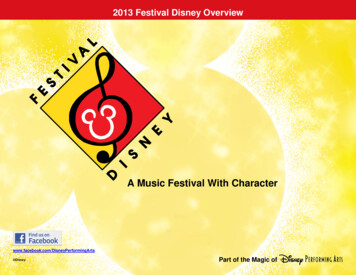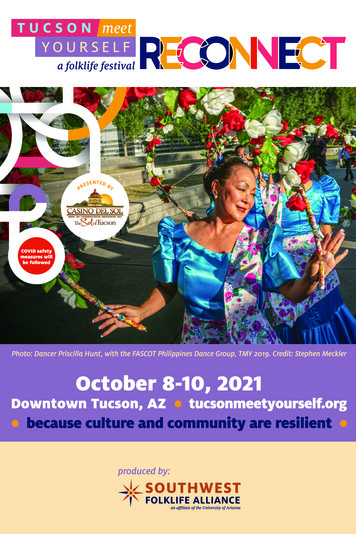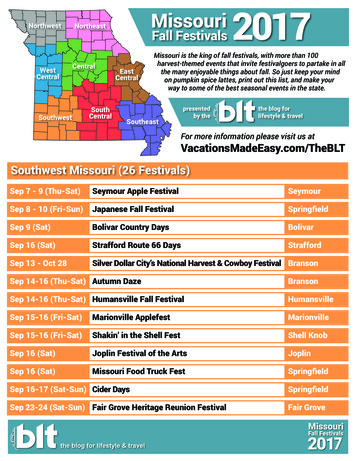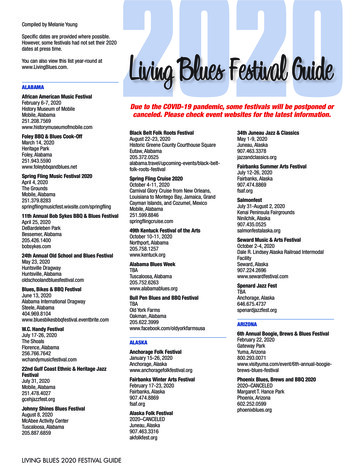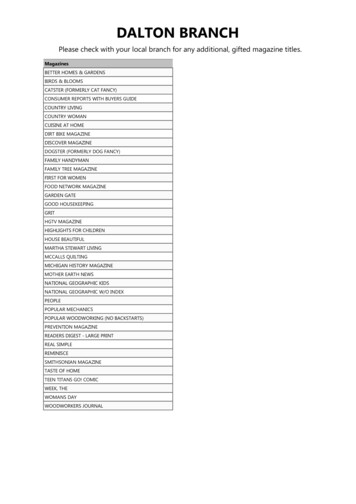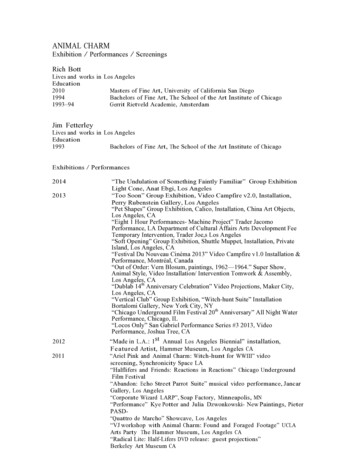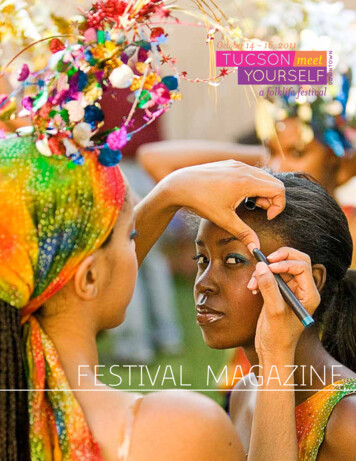
Transcription
Festival Magazine
Highlights ofOUR MISSION.is to research, document, interpretand present the living traditional artsand expressions of everyday life ofthe folk and ethnic communities of themulti-national Arizona-Sonora region.Editor: Maribel Alvarez, Ph.D.Contributing Writers: Monica Surfaro-Spigelman, Jim Griffith,Maribel AlvarezGraphic designers: Julie Ray, Jennifer Strass, Jennifer VaskoTMY Photographs: Steven Meckler38th Annual FestivalTucson Meet YourselfP.O. Box 42044Tucson, AZ 85733-2044520-370-05882011 Tucson Meet YourselfTABLE OF CONTENTS2Hats Off to Big JimIn 2011, we are producing the largest and most ambitious“Tucson Meet Yourself ” yet. In addition to the back-by-popular demand demonstrations by folk artists, delicious food, Iron Chef Competitions, Lowrider car show, interactive dance workshops, and music from all over the world in five stages, this year’s highlights include:3Public Folklore4Carvings of Culture:6Meet Your SoulA larger cross-border presence of artists and cultural8Brims, Traditions, & Trim10Food Scene in Sonora13O’Odham Traditional Arts14Traditions of Health &Wellness16Obituaries18Move Your Body20Supporters & Partners entrepreneurs from our neighboring Mexican state of Sonora;the first dedicated “Sonoran Pavilion” in an event of this sizein Tucson. New special activities focused on celebrating traditionsof health and wellness, including a huge and fabulous“flash workout” for all festival goers at 2pm on Saturday ---allpart of TMY’s exciting partnership with Pima County’s “Thisis My Healthy” (HealthyPima.org) campaign; A variety of expanded educational programs, including a newactivity book “Passport to the World” for kids and thejoint presentation during Tucson Meet Yourself of the 3rd Annual TUSD Festival of Schools, featuring exhibits from morethan 100 TUSD schools and programs in addition to an arrayof student performances.The TMY festival is always preceded by scholarly research and extensive relationship-building with the variety of living traditionalartists, folk groups, and ethnic communities that reside here. TMYalso doubles as a fundraising platform for more than 50 non-profitclubs, cultural organizations, and small ethnic entrepreneurs andsmall business owners that collectively generate close to 250,000through sales at the festival. All this money (plus all the love andgood will) goes right back into the community!www.tucsonmeetyourself.org22011 Tucson Meet Yourself2011 Tucson Meet Yourself1
Apopular proverb says that “no one is a prophet inhis own land.” Well, so much for that. Our ownTucson Meet Yourself Founder, Dr. James “BigJim” Griffith, is not only a beloved “prophet”and teacher for many residents of these borderlands – nowhis exceptional work has been recognized and honored atthe national level.In September 2011 the National Endowment for the Artspresented Big Jim with the “Bess Lomax Hawes NEA National Heritage Fellowship” award. The Bess Lomax HawesAward recognizes an individual who has made a significantcontribution to the preservation and awareness of culturalheritage. This award is the nation’s highest honor in the folkand traditional arts.In receiving this award, “our” Big Jim joins the ranks ofprevious Heritage Fellows, including bluesman B.B. King,Cajun fiddler and composer Michael Doucet, cowboypoet Wally McRae, gospel andsoulsingerMavisStaples,and bluegrassmusic i a nBillMonro e.Since 1982,the Endowmenthas22 0 11 Tu c s o n Me e t You rs elfHats offto Big Jimawarded 367 NEA National Heritage Fellowships. Fellowship recipients are nominated by the public, often by members of their own communities, and then judged by a panelof experts in folk and traditional arts on the basis of theircontinuing artistic accomplishments and contributions aspractitioners and teachers. In 2011 the panel reviewed 210nominations for the nine fellowships. The ratio of winners tonominees indicates the select nature of this national honor.It’s hard to imagine anyone in Arizona more deserving ofthis recognition for their work promoting, with the greatestsincerity and integrity, what the late Bess Lomax Hawes oncecalled “the beauty of ordinary genius.” For more than fourdecades, Big Jim has been devoted to celebrating and honoring the folkways, religious expressions, and everyday artisticembellishments found along the United States-Mexico border. Jim has worked as both an academic and public folklorist (see his essay on this distinction on the next page).Born in Santa Barbara, California, Griffith came to Tucson in 1955 to attend the University of Arizona, where hereceived three degrees, including a PhD in cultural anthropology and art history. From 1979 to 1998, Griffith led theuniversity’s Southwest Folklore Center. Through his workthere, he wrote and published several books on southernArizonaand northern Mexico folk and religious art traditions, including Hechoa Mano: The Traditional Arts ofTucson’s Mexican American Community and Saints of the Southwest.In addition, Big Jim hosted for manyyears Southern Arizona Traditions, a television spot on KUAT-TV’s Arizona Illustratedprogram. He has curated numerous exhibitionson regional traditional arts including La CadenaQue No Se Corta/The Unbroken Chain: The Traditional Arts of Tucson’s Mexican American Community at the University of Arizona Museum ofArt. In 1974, Big Jim and his wife Loma, with thehelp of several community members, co-foundedTucson Meet Yourself. His professional commitment has always been to understand the cultures ofthe Southwest region and to pass along that knowledgeand understanding to the public as respectfully and accurately as possible.PUBLIC FOLKLORESome Thoughts From a Practitionerby Jim Griffth, Ph.D.Askunk is pretty easy to identify, once you’veexperienced it. So is a piece of chocolate cake.Little thought or training is needed, just onesolid encounter. Not so folklore.This is because folklore depends on context for its identity, rather than its appearance. Folklore, be it song, story,food, or art object, comes out of a community of people. Thiscommunal connection – and the community can be as smallas a family or as fleeting as a fifth grade class – is what makesit folk-lore. Folklore doesn’t have to originate within thecommunity, either – it can be “borrowed” from an outsidesource and adapted to reflect the needs of the community.Folklorists study folklore, because by examining the informal cultural products of the community one can learn aboutthe community’s values, hopes, and concerns.Just to make things more confusing, there seem to be twokinds of folklorists: academic and public. Both kinds usuallyhave advanced degrees, but the distinction arises in whomthey select for their audience. Academic folklorists function mostly in, well, an academic context, communicatingmostly with other folklorists, and advancing the scope andtheory of their chosen field. Their chosen theaters of actionare the classroom, the journal article, and the book. Publicfolklorists, on the other hand, have chosen to communicatemostly with the general public. They do so through concerts,lectures, films, video and sound recordings, exhibits, socialmedia, and festivals. They use books and articles as well, butthe articles tend to be in popular magazines, and the booksshould appeal to the interested general reader. Each kind offolklorist can and should depend on the other’s work.The two folklorists who are involved in Tucson MeetYourself, Maribel Álvarez and Jim Griffith, are public folklorists. Each hold a Ph.D., each has taught in a Universitysetting, and each has written materials that are quoted byother folklorists. However, the primary concern of each liesbeyond the groves of academe.Tucson Meet Yourself was originated by Jim and is nowcarried on by Maribel as a project in public folklore, designedto introduce our fellow Tucsonans to the creative traditionsof the various communities that exist among us. It a seriousproject undertaken for serious reasons – we think it helpsTucson become a better place for all of us to live. But it isalso designed to be fun. If it weren’t, nobody would show up.It is this combination of seriousness, professional accuracyand excitement that makes for a successful public folkloreproject.2011 Tucson Meet Yourself3
Carvingsof CultureYoe m e A r t i stLouis David ValenzuelaBy Monica Surfaro-Spigelmanbrows and beards and such for the old man. These are tuftsof horsehair inserted through the holes I make. People approach me and ask if I need horsehair. They have the whitehorsehair, the common hair we use that represents the oldman at the fiesta. The paints are mostly acrylic. But I wantto go back to the original ways. In the old days they wouldburn the masks to get the black marks. They didn’t use blackpaint. And the white was ground from the horns of whitetailed deer into a powder mixed with the lard from deer.The red stain came from prickly pear and other plants.Many of your masks are in collections. Whatdo you want people to understand aboutcollecting masks?Louis David Valenzuela, member of the Pascua Yaqui (also known as Yoeme) tribe, honors his culture’s art form with his finely-detailed ensemblesof wood, each decorated expressively with symbols and horsehair. He is oneof the few remaining traditional Pascola (pahko’ola) mask carvers.How does the tradition of Pascola maskcarving inspire you?Your art seems to all begin with the wood. Tellus about this.LDV: The masks represent the past, present and the future,all the love and respect of our people. The mask is worn bythe Pascola dancer, the old man of the fiesta, the story tellerwho represents the hunter looking for the deer. He is central to our culture and our ceremonies. One time when I was17, I saw some elders carving masks, and I sat with them. Iwanted to see if I could create the masks, all their colors andimages. My first mask was very rough; it took time, like anything in life, it took practice.LDV: It is a gift given to me, to create the beauty of our culturefrom the wood just laying there. The main thing I rememberis the respect to the Creator and to Mother Nature. When weget our wood we say prayers, we ask permission to honor thebeauty of life. I was taught by my mentor to feel for the wood.It seems that the wood is calling you, wants to go with you.We don’t cut trees down; we take the pieces laying there thatcall to us. I look at the different forms, the grain look at thebeauty of it before it is even made into a piece of art.Tell us about your mentors and what youlearned from them.Is it a long process to shaping the mask fromthe wood? What tools do you use?LDV: Arturo Montoya was my first mentor in 1978. He wasa Mexican-American sculptor, not Yaqui, but he taught methe basics of painting and mixing colors. The other man Ihave a lot of respect for is elder Jesus Acuña. When I was 17 Isaw him carving. He taught me so much about the wood andtools to use. He never wanted his name to be out there buthe is an amazing artist. I did go to the Chicago Art Institutefor a year but for me it was never about a degree, it was justabout my art, my culture and imagining the stories that cometo life in my carvings and masks.LDV: I start with blocks. I use the machete to form what I seein the wood. After I form the face out, to what I want, then Istart using a chisel and a file. With the file, I shape and shape,it flows from the wood and becomes the oval face. I smooththe edges. And then I just use a utility or box knife for theedging and to form the features. I tried using fancy carvingtools but they were not right for me.There are other elements at work on the mask,such as the horsehair and the paints.LDV: The last things to be added to the mask are the eye-42011 Tucson Meet YourselfLDV: All the masks I make for collections are different fromthe masks made for a Pascola dancer. The Pascola mask issacred. The collector mask is beautiful also but it is mostlyfor education. Masks are not to play around with. The masksI sell are brought out to educate people about my culture andto give our people the recognition we deserve.You speak about your people. Can you tells usabout your family?LDV: My Uncle Anselmo would tell me that our peopleneeded to open the door and tell others about our culture,to explain its beauty. My Uncle was a deer singer, an elderwho established with other elders the first tribal council administration. My Uncle seemed to always know I had a gift.There was a period in my life that I was into drugs and alcohol addiction. And my Uncle would sit down with me andsay, “Mijo, you need to get your life together. You don’t know,but you are important to our people.” Now I know why. I amnow going on almost seven years sobriety and I look back tomy Uncle’s words to understand now why he wanted me toget stronger.What is next for you as an artist?LDV: I am living my dreams as an artist, and what theCreator put in front of me. My carvings are different fromthe masks. They have modern expressions. They representme and stories that I want to tell. An important part of whatI do now is teaching the younger generation. There are moreartists out there, but they need to be encouraged. We need tokeep our tradition going. There are a lot of young buckarooswho will soon have their own machetes! There is timing oneverything in life. I started at 10 years of age and have beendoing art for 38 years. You can’t force it.2011 Tucson Meet Yourself5
FsoulTucson Meet YourAfrican American MusicalTraditions “Sound a JoyfulNoise” at TMY Festivalby Maribel Alvarez, Ph.D.rom the very first festival in 1974 and everyyear since, Tucson Meet Yourself has always included African-American traditional arts. Frombarbecue to blues, from quilting to gospel, festival organizers and folklorists have always done their bestto explore the rich expressions resulting from the AfricanDiaspora. According to festival founder “Big Jim” Griffith,memories of the earliest years include the harmonica bluesof Harmonica King Jones, the solo Gospel singing of NormaReynolds (see large image on opposite page) and the spiritfilled presentations of Mother Shaw and the Special Choir ofNew Hope Baptist Church of Casa Grande.Even though according to the U.S. Census, the AfricanAmerican population in Tucson is relatively small (about4%), the size of the folk group or community has never beena consideration for TMY when it comes to appreciating andshowcasing the incredible beauty and complexity of AfricanAmerican traditional creations.Since 2010, Tucson Meet Yourself has been collaboratingwith Southwest Soul Circuit to program the highly popularand dynamic “Tucson Meet Your Soul” stage (at La PlacitaVillage). The Southwest Soul Circuit is a Tucson-based music production business that specializes in live stage performances and studio recordings. The company is the brainchildand life’s passion of Kevin and Tanishia Hamilton (picturedon the left), who have participated in Tucson Meet Yourself as performers for the past 5 years. “Our mission,” saidTanishia, “is to uplift, inspire, and entertain the Southwestcommunity by combining music and community service.”In 2008, Kevin and Tanishia formed a vocal coaching andmusic instruction company to produce records and train local aspiring singers and musicians. In that same year, theyformed a partnership with the non-profit organization Garden Youth Development Project, Inc. to facilitate access tocreate a quality learning environment for community youthto develop life skills through the arts.The Tucson Meet Your Soul stage in 2011 features animpressive and original line-up that includes various wellknown local artists in the genres of Jazz, Blues, R&B, Soul,and Gospel. But Kevin and Tanishia want to dig deeper thansimply providing fun and entertainment for festival participants.The Soul stage is also hosting two special events this year: 62011 Tucson Meet Yourselfbest Hip Hop music and Spoken Word that Tucsonhas to offer; performances will be followed by a paneldiscussion which will consider Hip Hop’s trajectoryfrom it’s humble beginnings as an authentic expression of community voice to it’s present state of commercial success and transformation. Sunday afternoon, crowning three packed days offestival intensity, Kevin and Tanishia put together the“Tucson Gospel Explosion.” “Our desire and intention,” said Kevin, “is to showcase a variety of sacredmusic ranging from traditional spirituals to contemporary gospel music performed by over 15 gospelgroups from Casa Grande to Sierra Vista, AZ.”Kevin and Tanishia have organized the first “RealHip Hop Soiree” which seeks to present the culturallyrich aspects of the art form of Hip Hop music. Festival participants will be treated to hearing the very2011 Tucson Meet Yourself7
Brims,The Heart and Soul ofTraditionsAfrican-American Hat-Makingand TrimBy Monica Surfaro-SpigelmanAswirl of imported satin covers the work table inthis small Tucson studio. There’s a mix of stones,flowers, feathers and assorted fabric swatchescast across another table nearby. Encircled within all the color and adornment is an elegant woman, intentlyshaping a hat onto an old-fashioned block. She cuts andtrims, then gathers, pins and folds – and the hat is seeminglycoming to life in her hands.As her mother and grandmother before her, Toni Hamis a milliner and artist. In Centerville, the small Texas townoutside of Houston where she was born, Toni learned thata woman needed her hat to be completely dressed. Becausestore-bought wasn’t an option, the women in Toni’s familymade their own hats. “All ladies had their hats, you neededto show your finest in church,” remembers Toni, whose firsthat was a simple fabric bonnet with ribbon ties made byher grandmother. Toni explains how a hat was also a way toshow style and attitude. “It mattered how you perched it onyour head — sideways, you know, or straight down. A veil,or not. The hat was the prize accessory for any outfit, it wasour way to be special.”“My grandmother was part Cherokee, part French,” Toninotes. She recalls how her grandmother would intuitivelypick up a piece of fabric and know how to gather it into afine headpiece. “She would look at her fabrics and her hats,and ask, what will you become?” Toni recounts. Toni alsolearned detail from her grandmother – about adding veiling strategically to add texture and interest. “Grandmotherencouraged me to add my own flair,” Toni notes.Hat’s HistoryDonning something beautiful onto the head has been a subject of fashion and tradition throughout history. As early asthe 15th century, in the duchy of Milan (a collection of 26small towns that spanned the northern Italian hills to the lagoons of Venice), headpieces were known as Millayne bonnets (thus, the root of the modern English word, Milliner).After the 16th century, the Anglo Saxon word, haet, emerged,signifying a wide brimmed covering for head.Headwear changed through the ages. There were caps inEngland and bonnets in France. Around 1900 in America,hats were the sign of class. African-American women ofthe era embraced hats as a source of dignity, as a way to riseabove the dreariness, and as a way to dress their finest forSunday church services.“Dressing for church was one of the few ways we hadto feel special,” says Toni, who likes to underscore the joyand the tradition of African-American hat-wearing, not thedreariness of segregated times. “Just no ordinary hat would82011 Tucson Meet Yourselfdo. All those bright colors showed confidence. You neverwere hatless in Church or when you were stepping out. Youwere telling the world you are fabulous!”Dressing and DetailIn Centerville, Toni learned a variety of crafts that celebrated beauty, decoration and fashion. Toni’s grandmotherand mother were dressmakers, too – they wouldfashion clothes out of flour sacks that borecolorful decorative symbols in that era.They made men’s suits, as well. “Myfamily used very fine patterns,especially to create those meticulous seams, buttonholes andpockets. Both my grandmotherand mother taught me to be particular about the construction andthe details.”By the time she was a teen, Tonialready was selling her hats, dressmaking anddecorating. She continued to put her skills and herpassion for hat-making to work when she moved to Tucsonin the 1980s. She founded her Toni’s Designs business fromher home, as a way to carry on the traditions she loved. “I didinterior decorating, styled hair, and also made men’s suits,but I never used a pattern or went to school,” she says.Toni loves color, like cherry red or butterscotch or Frenchlavender. She notices, though, that there are fewer and fewermilliners these days. “It’s sad, because a custom-made hatturns heads, “ she says. “Making a hat is like bringing alivea new world,” says Toni. “I always have a vision of a desiredeffect, the sparkle. No two hats are alike.” Toni herself hasmore than 40 hats, a favorite being a pillbox decorated withold earrings and feathers.Reference: Marberry, Craig Crowns: Portraits of Black Women in ChurchHats New York: Knopf Doubleday, 2000“She recalls how her grandmotherwould intuitively pick up a piece offabric and know how to gather itinto a fine headpiece. She wouldlook at her fabrics and her hats,and ask, what will you become?”2011 Tucson Meet Yourself9
The FoodScene inSonoraBy Jim Griffith, Ph.D.If I were writing about the foods of any region ofcentral or southern Mexico, I would start with a richfoundation of surviving pre-Hispanic dishes andtechniques upon which today’s foods are based. Butthis is Sonora, the far Northwestern frontier, and whateverlarge population concentrations there had been got prettymuch wiped out by introduced diseases in the 16th and 17thcenturies. So our baseline must be the arrival of the Jesuitmissionaries in the early 17th century.They brought with them new crops – wheat, garbanzos, and fruit trees among them - and new domesticanimals, especially cattle and pigs, that changed Sonoranlife forever, to the extent that a noted 20th-century Mexicaneducator is said to have characterized the region as “wherecivilization ends and carne asada begins.”1 So let’s start withbeef. Much of Sonora is still ranching country, and beef stillanchors the Sonoran diet in many ways. As carne asada, itcan be the basis of almost any important meal, outdoors orin; chopped or shredded and mixed with a red chile sauce,it becomes carne de chile colorado. Chopped fine, it is usedto fill tacos, enchiladas, and burros (not to mention chimichangas, which are deep-fried burros; in the east-coast statesof Tabasco and Vera Cruz, “chimichanga” means somethinglike “thingamajig.”). Dried, it becomes carne seca, and whenyou pound carne seca into tiny shreds, it becomes machaca.In fact, thrifty Sonoran ranch folks use every part of thecow except perhaps the moo. Beef marrow, guts, or tripas deleche, are a favorite outdoor food. And menudo, a savory stewof beef tripe and hominy is a favorite weekend breakfast dish.And I haven’t mentioned the beef dishes whose name conceals their bovine nature. Gallina pinta, (“speckled chicken”)for instance, consists of ox tail, beans and hominy, cooked ina rich broth. Cocido (“cooked”) is a beef-and vegetable stew,while cazuela (“cooking pan,” “casserole”) is machaca stewedup with potatoes, onions, tomatos and green chiles. Cheese,of course, comes from the same animal, and is made all overSonora. There is the drier, salty queso ranchero or queso regional, and the more rubbery queso cocido, which is best formelting. In other words, beef in one form or another appearseverywhere on Sonoran tables.As does wheat flour, especially in the form of tortillas. Thetraditional corn tortilla of Mexico is made all over Sonora,of course, but most Sonorans recognize that the wheat flourtortilla – the tortilla de harina – is especially theirs. Flourtortillas (tortillas de harina) can range in size from less thanfive inches to over thirty inches across. The truly huge onescan be called tortillas de jalón (“stretched tortillas”) or eventortillas sobaqueras (“armpit tortillas.”). Although the word“sobaquera” is used widely by working class Sonorenses andcan be spotted throughout the state, even in advertisementsat food establishments, it is important to note that some Sonorans object to the term and its association to somethingvulgar. Tortillas de manteca or gorditas are small, relativelythick, and contain milk. Home-made Sonoran breads include semitas or biscuits and rolls. And of course there arebakeries all over Sonora, turning out the full repertoire ofluscious Mexican breads and cookies.Of course Sonora’s western border lies on the Gulf ofCalifornia, and the state’s coastal regions have a rich repertoire of fish and seafood. But few of these dishes, tantalizingthough they may be, have come to be identified as specifically Sonoran.Not so the famous “Three Sisters” of corn, beans, andsquash. These vegetables were important before the Spaniards arrived, and they remain so today, though not alwaysin their original varieties. Corn is made into nixtamal orhominy and ground into masa. Beans are boiled, then maybe fried. Squash is cooked up with onions and chile, A fewdishes should be singled out: parched hominy, cooked up ina broth of red chile, tomatoes, onions and garlic, becomeschicos. Fresh corn is ground into masa, and steamed in itsown husks to become tamales de elote or green corn tamales.But these are for the most part variations on national dishes.More truly Sonoran are the flat, or Sonoran enchiladas.These are thick cakes of masa into which some red chilesauce and cheese have been added. The cakes are then fried,served with red chile sauce and garnished with chopped onion and lettuce, oregano, dry cheese, and oregano. Considered a local specialty, they are nevertheless related to suchpan-Mexican dishes as sopes.We come at last to the wild, native foods of Sonora. During the rainy season, many people collect, cook and eatgreens like verdolagas (purslane) and quelites (amaranth).The tiny, fiery-hot sonoran chiltepines are still gathered wildand add their own scorching quality to local foods. Atoles-gruels – are made from ground mesquite beans. Tiny acorns– bellotas – are eaten as snack food. Finally, the juice of theagave is distilled to become bacanora, the local version ofmezcal.And there you have it! Pretty rich fare for what isby many Mexicans considered the desert at the end of theworld!Two cookbooks specialize in Sonoran food:Cocina Sonorense (Fifth Edition), by Ernesto Camou Healyand Alicia Hinajosa. Hermosillo: Instituto Sonorense de Cultura,2006.El Sabor de Sonora, by Elsa Olivares Duarte, Hermosillo: EditorialImágenes de Sonora, S.A. de C.V.2009Pozole de TrigoINGREDIENTES½ kilo de trigo duro½ kilo de costillas de agujas½ kilo de pulpa½ kilo de pecho3 cabezas grades de ajo3 cebollas3 manojos de verdolagas3 elotes en pedazos2 calabacitas½ kilo de camote½ kilo de papa½ repollo3 zanahorias¼ de kilo de tomate2 chile verdesPREPARACIÓN Y PROCEDIMIENTOSe lava el trigo y se one a remojar durante unahora; se escurre y se raspa en el metate para quitarle la cascarilla y quebrajarlo un poco. Se pone acocer en quatro litros de agua.Cuando tiene media hora de estar hirviendo se leponen las carnes, el ajo, las cebollas y la sal. Cuando las carnes están cocidas se agregan todaslas verduras, los chiles enteros y el tomate picado.Se deja hervir hasta que todo está bien cocido. Sesirve bien caliente.Recipe from the book Cocina Sonorense (Camou and Hinajosa)1 This popular statement was actually said by José Vasconcelos in his book La102011 Tucson Meet YourselfTormenta and the exact words were: “Donde termina el guiso y empieza la carneasada, comienza la barbarie.”2011 Tucson Meet Yourself11
O’OdhamTraditional ArtsHIRAM ENOScolor soundMiniature basketry is one of the oldest O’odham weavingcrafts, and tradition-bearer Hiram Enos uses horsehair inhis art. Hiram weaves spiritual and symbolic themes into hisprized miniature baskets, plates and jewelry, which represent many hours of painstaking artistry. Note his techniquein the weaving of his intricate designs.tasteMARGARET ACOSTAHiram EnosThe baskets woven by Margaret Acosta reflect a rich varietyof designs that are striking contemporary interpretations ofan ancient craft. Margaret uses bear grass, yucca and otherplant materials native to the Sonoran Desert in her finelycoiled baskets, which traditionally were used for practicalpurposes such as washing, mixing or collecting fruit. Herwork reflects the traditional “v” stitch and her delicate coilhandiwork includes patterns such as Whirlwind, CoyoteTracks, Deer Tracks, Squash blossom, Man-in-the-Maze,and Cactus Harvest (includes a lady harvesting saguarofruit, a deer, a man, and a dog). A contemporary pattern shecreated is the ‘Ribbon Pattern’ which she interprets as a timeof ‘Celebration.’ROSALINE SERAPOMargaret Acosta122011 Tucson Meet YourselfRosaline SerapoRosaline Serapo’s plating technique brings to basketry abeautiful bazaar of weaving tradition. She uses willow, yucca, and other native materials such as Common Sotol, akaDesert Spoon or Blue Sotol, to craft the fine lines of her winnowing baskets, adding subtleties of design and form to herwork. Common Sotol can be gathered at any time. Historically, because of the spiny edges, women carried long sticksto sever the leave from the plants. The leaves were dried andwhen needed, water was poured over them and the stripsleft overnight in the damp earth. In the morning, they werepliable enough to plait without splitting. Rosaline practicesthe twilled plaiting technique (with only oblique elements)to weave mats, headbands, back mats, cylindrical baskets forholding trinkets, clothing, and food-stuffs and rectangularbaskets to hold medicinal and magical items. She is a basketmaker who varies the technique in her baskets, revealingboth creativity and technical mastery of her art form.2011 Tucson Meet Your
images. My first mask was very rough; it took time, like any-thing in life, it took practice. Tell us about your mentors and what you learned from them. LDV: Arturo Montoya was my first mentor in 1978. He was a Mexican-American sculptor, not Yaqui, but he taught me
